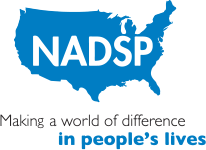
Supporting Different Modes Of Communication
The following article is part of an ongoing series about the NADSP Competency Areas. The NADSP Competency Areas offer DSPs the opportunity to address challenges, work on issues identified by the person they support, or assist a person in pursuing a particular goal. Each Competency Area has corresponding skill statements that describe the knowledge and skills DSPs must have to demonstrate competency in each area.
This blog is about the skill statement “The competent DSP has knowledge of and uses modes of communication that are appropriate to the communication needs of participants,” within the NADSP Competency Area: “Communication.”
Inside The Competency Area
Communication
Direct support professionals are obligated to understand what communication means as it relates to the impact on people they support. Communication has a vast definition and when we discuss communication as a skill or competency, we must define exactly what communication is.
Direct support professionals work with people who have different kinds of disabilities. It is common for people to have unique and non-traditional methods of communication. We all must understand that everyone communicates in their own way. There is nobody on the planet who does not communicate. Our obligation is to figure out how the people we support actually do communicate. This can come is so many ways and demonstrates the importance of this competency area we’re exploring.
The competent DSP has knowledge of and uses modes of communication that are appropriate to the communication needs of participants.
Inside The Skill Statement
The competent DSP has knowledge of and uses modes of communication that are appropriate to the communication needs of participants.
Direct support professionals must be diligent, curious and willing to explore all the different ways that human beings communicate. These can include words, gestures, body language, writing, digital communication, intuition, and so many other ways that humans connect with one another. Direct support professionals must be knowledgeable about the range of communication styles that can occur.
Direct support services are based on developing relationships, so the direct support professional should help facilitate self-determination, personal growth, increased autonomy and self- esteem. This is impossible to do unless there can be lines of communication set between the direct support professional and the persons they support.
The Impact On People Supported
One of the most important parts of being a human being is connecting to others. Think of when we learn a new language or have someone translate something for us from a person using a foreign language. The moment we learn what is being “communicated” is a moment we have true connection and understanding. If the people we support aren’t given the opportunity to be heard, listened-to and connected with others, their lives are less full and less enriched.
Everyone can communicate. Too often in history people with significant communication difficulties and disabilities have been excluded from life, literally. When we, as direct support professionals, can form partnerships and alliances with people we support who experience communication disabilities and difficulties, it is clear we must understand and be well-versed in the ways and preferred methods for people to express their thoughts, feelings, needs, wants, dreams and desires.
Putting It All Into Practice
As direct support professionals set out to build collaborative and respectful relationships with the people they support, they must first establish the best ways to connect and communicate with those receiving services.
For instance, if a direct support professional is supporting a person who uses adaptive communication devices such as an iPad or communication board, the direct support professional needs to become familiarized with the technology. This may mean that the direct support professional takes an online class to learn about the latest electronic or tablet-based communication devices and developments.
After that, it should be the direct support professional’s responsibility to learn how the technology is utilized by the person. The direct support professional needs to ensure the tablet is fully charged, clean and set up for usage. They also need to be sure that the person using it has developed skills and understands the device as much as others. In addition, the direct support professional should learn to be gracious and patient if the person they support needs extra time to type, use eye-movement technology or orthopedic adaptive devices for communicating.
All of this is a competency and skill!
Quick Tips
How can you help embrace this skill statement and implement it? Here are some quick tips!
-
- Find out how the person you support prefers to communicate
- Listen before responding and speaking
- Learn about forms of communication other than human speech/language
- Discover the wonderful language of ASL
- Body language “speaks” volumes so be aware of yours and the person you support
- Be patient and gracious with people, regardless of communication method
- Just because someone cannot speak does not mean they have nothing to say!
NADSP Competency Areas
The NADSP Competency Areas offer DSPs the opportunity to address challenges, work on issues identified by the person they support, or assist someone in pursuing a goal.
You May Also Be Interested In …

Let’s Talk: Embracing Diversity Equity and Inclusion: A Pathway to Professional Excellence for DSPs

Let’s Talk: Burnout: Reclaiming Mental Wellness in Direct Support Work

Let’s Talk: Flipping the Switch: Compassion Fatigue to Compassion Satisfaction and Psychological Safety for Direct Support Professionals

Let’s Talk: Sexuality and Healthy Relationship Knowledge is Power

Let’s Talk: Balancing Joy, Boundaries, and Belonging: The Ethical Role of DSPs in Holiday Celebration and Connection

Webinar: The Future of COVID-19 and Vaccines

International Journal: A Deep Dive Into The NADSP Code Of Ethics

International Journal: Ethics For Direct Support Professionals

